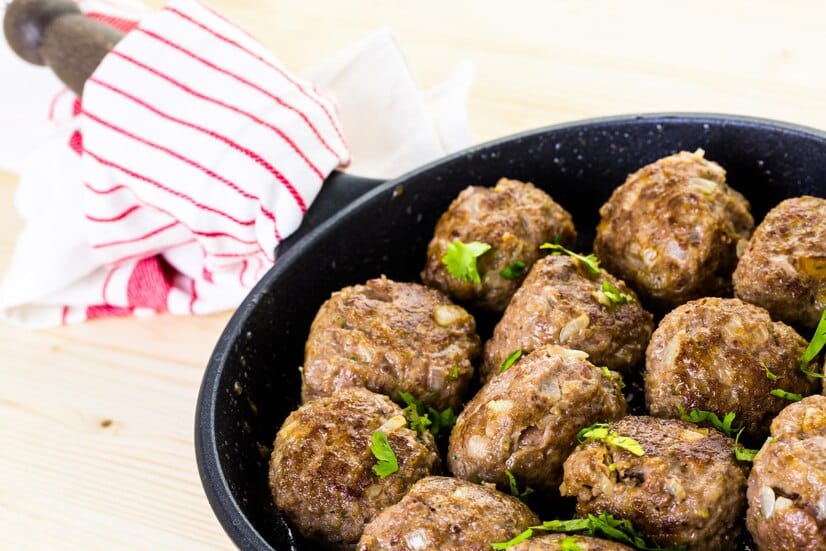Meatballs are a universal favorite, cherished for their versatility and rich flavors. However, traditional meatball recipes often include gluten-containing ingredients like breadcrumbs. For those adhering to a gluten-free diet due to celiac disease, gluten sensitivity, or personal preference, this poses a challenge.
Thankfully, gluten-free meatballs offer a solution, combining all the savory goodness of traditional recipes with safe, gluten-free alternatives. Whether you’re hosting a dinner party, meal-prepping, or simply craving comfort food, these meatballs are a fantastic choice. Moreover, explore this ultimate guide to gluten-free meatballs for creative ideas and tips.
Understanding Gluten-Free Cooking
Cooking without gluten may seem challenging at first, but with the right knowledge and ingredient swaps, you can create delicious meals that are safe for those with celiac disease or gluten sensitivity. By understanding what gluten is and how to replace it in recipes, you can enjoy a wide variety of flavorful, satisfying dishes without worry.
What Is Gluten?
Gluten is a protein found in wheat, barley, and rye, commonly used as a binding agent in baked goods, pasta, sauces, and many processed foods. It provides elasticity and structure to dough, giving bread its chewy texture. However, for individuals with celiac disease, gluten sensitivity, or wheat allergies, consuming even small amounts of gluten can cause severe health issues, including digestive distress, inflammation, and long-term intestinal damage.
Fortunately, gluten-free cooking allows for endless culinary possibilities with the use of safe, nutritious substitutes.
Common Gluten-Free Substitutes
1. Replacing Breadcrumbs
Breadcrumbs are often used in meatballs, coatings, and stuffing, but traditional breadcrumbs contain gluten. Here are some great gluten-free alternatives:
- Almond flour – Adds a slightly nutty flavor and provides structure.
- Crushed rice crackers – A crunchy, neutral-tasting alternative.
- Ground oats (certified gluten-free) – Mimics the texture of breadcrumbs while adding fiber.
- Gluten-free panko – Available in stores, these provide a crispy texture similar to traditional panko.
2. Using Binders in Recipes
Gluten often acts as a binder, helping to hold ingredients together. When cooking gluten-free, you can use these effective alternatives:
- Eggs – A natural binder that works well in meatballs, burgers, and baked goods.
- Flaxseed or chia seeds mixed with water – A great vegan substitute; mix 1 tablespoon of flaxseed or chia seeds with 3 tablespoons of water and let it sit for a few minutes to form a gel-like consistency.
- Mashed potatoes – Adds moisture and helps bind ingredients in dishes like meatballs or veggie patties.
- Potato starch or cornstarch – Useful in thickening sauces, gravies, and soups without gluten.
3. Checking Seasonings and Condiments
Many people overlook the fact that seasonings, sauces, and condiments can contain hidden gluten. To ensure your dishes remain completely gluten-free:
- Choose single-ingredient spices – Some spice blends contain fillers or anti-caking agents that may have gluten. Always check the label for “gluten-free” certification.
- Use gluten-free soy sauce or tamari – Traditional soy sauce contains wheat, but tamari is a great gluten-free alternative.
- Check pre-made sauces and dressings – Many gravies, salad dressings, and marinades contain wheat-based thickeners. Look for brands that specifically state they are gluten-free.
For a detailed guide to gluten-free seasoning ideas, check out this [article].
Embracing Gluten-Free Cooking
Switching to gluten-free cooking doesn’t mean sacrificing flavor or variety. By using smart substitutions and being mindful of hidden gluten sources, you can create delicious meals that everyone will love. Whether you’re making meatballs, baking bread, or preparing sauces, there are plenty of gluten-free options to explore.
Start experimenting with new ingredients, and enjoy the endless possibilities of gluten-free cooking!
Key Ingredients for Gluten-Free Meatballs
Creating perfect gluten-free meatballs starts with selecting the right ingredients, each contributing to flavor, texture, and cohesiveness. Here’s a more detailed exploration of the key components:
1. Ground Meat
Ground meat is the foundation of any meatball recipe, and its type significantly impacts the flavor, moisture, and texture. Here’s how to choose and combine your meats for the best results:
- Beef: A classic choice for its rich, savory flavor and slightly firm texture. Use ground beef with 80-85% lean meat to retain moisture while preventing excess grease.
- Pork: Adds a sweet, fatty richness that complements leaner meats like beef or chicken. It also enhances the tenderness of the meatballs.
- Turkey or Chicken: Leaner options that work well for lighter meatballs. However, they can dry out easily, so combining them with a fattier meat like pork or adding extra binders (e.g., eggs or milk-soaked breadcrumbs) helps maintain juiciness.
- Mixed Meats: Combining two or more types of meat, such as beef and pork or turkey and chicken, creates a balance of flavors and textures. For example, pork adds moisture to lean turkey, while beef adds depth to mild chicken.
Pro Tips:
- Keep It Cold: Always use chilled meat to prevent fat from melting during preparation, ensuring moist, tender meatballs.
- Test the Mixture: Fry a small patty of the meat mixture to taste for seasoning before shaping all the meatballs.
For more ideas on pairing meats and exploring flavor profiles, visit this guide to flavorful meat recipes.
2. Gluten-Free Breadcrumbs
Breadcrumbs are essential in meatball recipes, providing structure and helping bind the mixture. Gluten-free alternatives are versatile and ensure the meatballs maintain their integrity while meeting dietary restrictions. Here are some excellent options:
- Almond Flour: A low-carb, grain-free option that adds a subtle nutty flavor. Almond flour absorbs moisture effectively, helping to keep the meatballs tender and cohesive.
- Crushed Rice Crackers: These offer a mild flavor and crunchy texture. When finely crushed, they mimic traditional breadcrumbs and work exceptionally well as a binding agent.
- Certified Gluten-Free Oats: Finely ground oats are a reliable choice for replicating the texture of breadcrumbs. However, ensure they are certified gluten-free to avoid cross-contamination.
- Potato Flakes: Instant mashed potato flakes are another alternative that adds binding power and a soft, creamy texture.
- Store-Bought Gluten-Free Breadcrumbs: These are readily available and specifically designed to replace regular breadcrumbs in recipes, making them a convenient option.
Pro Tips:
- Pre-Soak Your Breadcrumbs: Soak breadcrumbs in milk, broth, or a dairy-free alternative before mixing to enhance binding and add moisture to the meatballs.
- Measure Carefully: Using too many breadcrumbs can make the meatballs dry and crumbly, while too few can result in them falling apart.
Discover more creative ways to incorporate gluten-free substitutes in this comprehensive guide.
Additional Notes
Combining the right ground meat with gluten-free breadcrumbs ensures a robust base for your meatballs. Experimenting with these ingredients allows you to adapt the recipe to your taste while accommodating gluten-free requirements. Let the creativity begin!
Seasonings
Enhance the flavor with fresh herbs, garlic powder, and onion powder. Pro Tip: Combine seasonings with your breadcrumbs for even distribution. For ideas on how to season meat dishes effectively, explore this recipe guide.Step-by-Step Guide
1. Preparation
- Chop fresh herbs and mince aromatics like garlic and onions for even flavor distribution.
- Whisk eggs or prepare flaxseed gel for binding.
- Measure and mix gluten-free breadcrumbs with herbs and spices before folding into ground meat.
2. Cooking Methods
- Baking: Preheat the oven to 375°F (190°C) and bake meatballs for 15-20 minutes, turning halfway for even cooking. Learn more about baking techniques in this recipe.
- Frying: Heat oil in a skillet over medium heat, cooking meatballs for 2-3 minutes per side until golden brown. For tips on achieving perfect frying, check out this cooking guide.
Sauces to Pair with Gluten-Free Meatballs
- Marinara Sauce: Pair your meatballs with a tangy, gluten-free tomato-based sauce. For inspiration, see how to elevate your sauces.
- Creamy Sauce: Add richness with a gluten-free cream-based sauce enhanced with garlic and Parmesan.
Storage and Reheating Tips
Refrigeration
- Store meatballs in an airtight container for up to 4 days. Ensure they are fully cooled to maintain texture and flavor.
Freezing
- Freeze cooked or raw meatballs on a tray before transferring to a freezer-safe bag. Properly stored, meatballs can last up to 3 months. For detailed freezing tips, refer to this guide.
Reheating
- Reheat meatballs in an oven or skillet for the best results. Microwaving is also an option, though it may affect texture.
FAQs About Gluten-Free Meatballs
1. Are Meatballs Naturally Gluten-Free?
Not always. Traditional meatball recipes often include gluten-containing ingredients such as breadcrumbs, which act as a binding agent. Additionally, some store-bought sauces and seasonings may contain hidden gluten, making it essential to check labels or opt for certified gluten-free products.
To make meatballs gluten-free:
- Replace breadcrumbs with alternatives like almond flour, gluten-free oats, or crushed rice crackers.
- Verify that all spices, sauces (like soy sauce or Worcestershire sauce), and condiments are labeled gluten-free.
- Use certified gluten-free meat products if there’s a risk of cross-contamination.
For more tips on how to adapt traditional recipes to be gluten-free, explore this detailed guide.
2. What Are the Best Binders for Gluten-Free Meatballs?
Binders are crucial for holding meatballs together and preventing them from falling apart during cooking. Here are the best gluten-free options:
- Eggs: The most common and effective binder, eggs add moisture and structure to the mixture.
- Mashed Potatoes: A creative alternative that adds creaminess while ensuring the meatballs stay intact.
- Flaxseed Gel: A vegan-friendly option made by mixing one tablespoon of ground flaxseed with three tablespoons of water to create a gel-like consistency.
- Potato Starch or Cornstarch: These gluten-free starches provide extra stickiness without altering the flavor of the meatballs.
- Soaked Gluten-Free Breadcrumbs: Combining breadcrumbs with a small amount of liquid creates a paste that works as an excellent binder.
Pro Tip: Adjust the amount of binder based on the moisture content of your meat and additional ingredients. For example, lean meats like turkey may require slightly more binder for the best texture.
For a deeper dive into gluten-free binding options, check out this comprehensive guide.
Conclusion
Making gluten-free meatballs is easier than ever with the right ingredients and techniques. By exploring alternatives and pairing them with complementary flavors, you can enjoy a satisfying meal that caters to dietary needs. For more inspiration, visit the ultimate guide to gluten-free meatballs.




